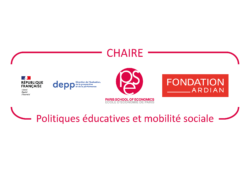> Read the note
Cite
G. Kenedi, L. Sirugue. Intergenerational income mobility in France: a comparative and geographical analysis. October 2023. IPP policy brief n°95
Presentation
To what extent are individuals’ incomes related to those of their parents?
This question is important to assess equality of opportunity within a society. This paper examines intergenerational income mobility in France, focusing on children born in the 1970s. Unlike existing work for France, the authors measure income at household level, providing a more accurate account of socio-economic positioning than individual income.
Key results
- Compared with other developed countries, France is characterised by low levels of intergenerational income mobility. Only 9.7% of children from families in the bottom 20% of the income distribution end up in the top 20% of households in adulthood, 4 times less than children from families in the top 20% of the income distribution
- The probability of obtaining a higher education degree increases sharply with parental income. Children from disadvantaged families are 2.5 times less likely to graduate from higher education than those from very advantaged families.
- Intergenerational mobility varies considerably across departments and appears to be particularly correlated with the local unemployment rate.
- Geographical mobility between childhood and adulthood is associated with a significant increase in upward mobility. Individuals born to parents with the lowest incomes who move to a high-income department reach on average the same level of income as children from well-off families who have not moved.
> Subscribe to receive next pole publications
Authors
- Gustave Kenedi is a post-doctoral researcher at the London School of Economics (CEP).
- Louis Sirugue is a doctoral student at the Paris School of Economics (PSE, EHESS, ICM, INED).
Reference study
Gustave Kenedi and Louis Sirugue, “Intergenerational Income Mobility in France: A Comparative and Geographic Analysis”, Journal of Public Economics, 2023.
DOI : 10.1016/j.jpubeco.2023.104974
Working paper: 10.2139/ssrn.4180259
Method and data
Sources
The data used for this study is the Permanent Demographic Sample (EDP), produced jointly by the National Institute for Statistics and Economic Studies (INSEE) and the General Directorate of Public Finances (DGFiP). Started in 1968, this database includes information from various administrative sources (civil registries, population censuses, matched employer-employee data and tax returns since 2011) for a representative subsample of the French population (individuals born on the first four days of October
Sample
The study covers people born in mainland France between 1972 and 1981, observed with their parents in the 1990 census and who filed a tax return between the ages of 35 and 45. The method used requires us to exclude children whose parent is a farmer or is in a liberal profession (e.g., lawyers, private doctors). In total, our analysis sample comprises 64,571 child-parent pairs. In total, our analysis sample comprises 64,571 child-parent pairs.
Parents’ income rank prediction.
The EDP follows the trajectories of individuals born on the first four days of October, which we call “EDP individuals”. Members of their families are not followed, unless they were also born on an EDP day. Thus, EDP individuals observed as children in the 1990 census are followed in the income data, but not their parents. Similarly, the EDP individuals observed in the 1990 census as adults are followed in the income data, but not their children. The authors select EDP individuals who had children between 1972 and 1981 (in metropolitan France) and were observed in the 1990 census to econometrically model the link between socio-demographic characteristics in the 1990 census and average gross wages between the ages of 35 and 45.
The results of this modelling are used to predict the gross wages of the parents in the sample of children. The characteristics used to make these predictions are level of education, detailed occupation, a set of demographic characteristics (year of birth, nationality, country of birth and household structure), as well as characteristics of the municipality of residence in 1990 (unemployment rate, share of single mothers, share of foreigners, number of inhabitants and population density). All these characteristics enable the authors to estimate the parents’ position in the income distribution with sufficient precision.
Method validity
The authors reproduced this exercise using US data from the Panel Study of Income Dynamics, a source that not only allows us to apply the same prediction methodology as that used in our study, but also to observe parents’ income directly. Comparing the results obtained using the two methods suggests that the position of parents in the income distribution can be reliably predicted on the basis of their observable characteristics, even if this approach slightly underestimates intergenerational income persistence with the indicators used in this policy brief..
Partners
This note was supported by the Educational Policies and Social Mobility Chair. Created in 2021 as part of a partnership between the Ardian Foundation, the Direction de l’évaluation, de la prospective et de la performance of the French Ministry of Education and Youth (MENJ-DEPP) and Paris School of Economics this chair aims to promote high-level research and the dissemination of knowledge on educational policies and social mobility.

This work has also benefited from State support managed by theAgence Nationale de la Recherche under the Investissements d’avenir program, reference ANR-10- EQPX-17 (Centre d’accès sécurisé aux données – CASD), from the ANR JOCE (reference ANR-18-CE41-0003-02), and from the Institut Convergences Migrations supported by the CNRS (reference ANR-17-CONV-0001).
Ce message est également disponible en :  French
French




